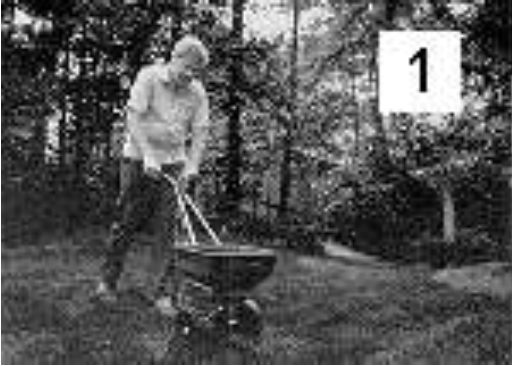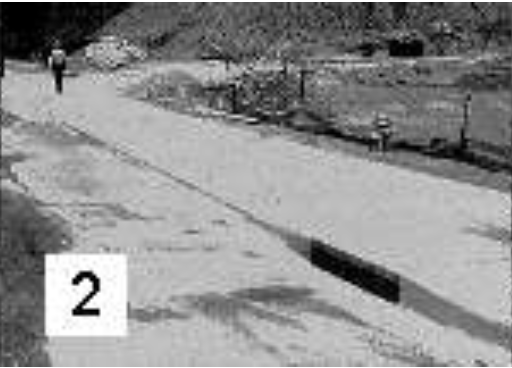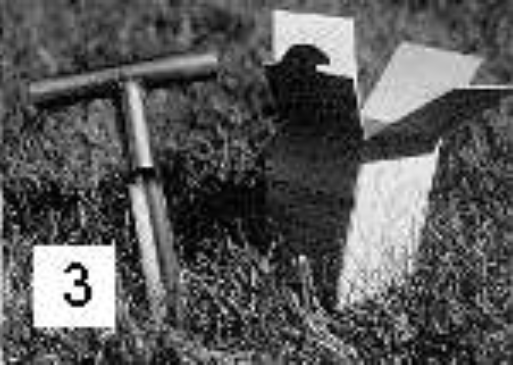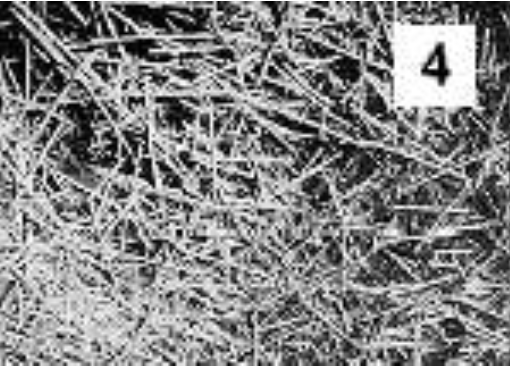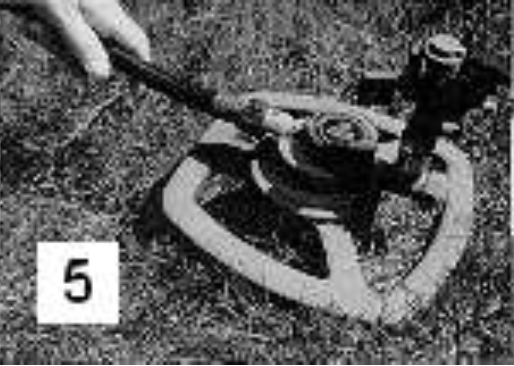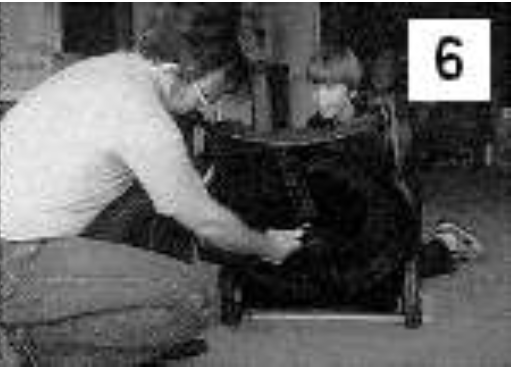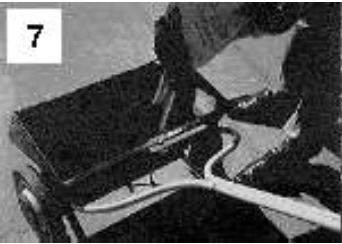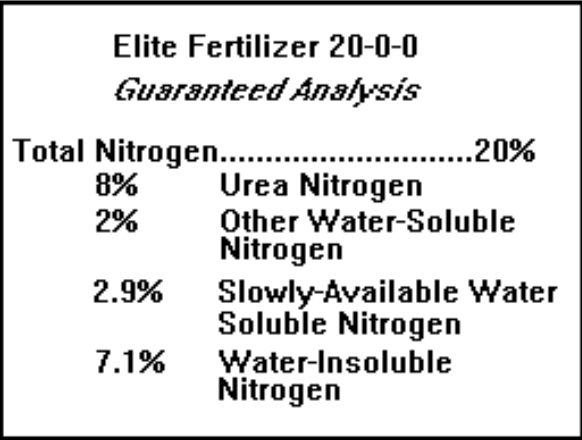Introduction
How you establish and manage your lawn has an impact on the quality of surface water and groundwater. Groundwater is the primary source of drinking water for 55 percent of all North Carolinians and 97 percent of the state's rural residents. Many effective techniques that help prevent and reduce water contamination by sediment, fertilizers, and pesticides are based on common sense. You can use these techniques and develop a lawn care plan that will help protect a very precious resource: water.
North Carolinians care for one million acres of home lawns. Each lawn is made up of thousands of grass plants capable of absorbing gaseous pollutants such as carbon dioxide and sulfur dioxide. Every plant can intercept pesticides, fertilizers, dust, soil, and water and release oxygen into the atmosphere. Together, these plants produce an extensive, fibrous root system that helps stabilize the soil and prevent erosion. In addition, most grasses produce a layer of plant material, called thatch, that accumulates between the soil and the green vegetation. If not too thick, this layer can be effective in capturing and breaking down pesticides.
Groundwater is water that collects beneath the earth's surface filling cracks and other openings in rocks and soil. Surface water is the water in streams, lakes, ponds, and rivers. Once contaminants such as certain kinds of nutrients, trace metals, bacteria, and pesticides reach groundwater, they may travel long distances, thus spreading the contamination. Soil eroded from a home with a poorly managed lawn may carry many contaminants to surface water. The transported sediment can clog lakes and ponds and carry chemicals into waterways, making them unsuitable for fishing, boating, and swimming.
The purpose of this publication is to provide practical steps you can take to have a healthy, attractive lawn and a cleaner water supply. You can make a difference by the proper establishment and management of your lawn.
Establishing a New Lawn
Some important issues in establishing a new lawn include selecting the proper grass, planting at the appropriate time, and following proven and recommended establishment techniques as outlined in Extension publication, Carolina Lawns (AG-69), available at your local Extension Center.
Soil Tests
Since the lime and nutrient requirements of soils varies greatly, the soil should be properly sampled and sent to a reputable soil testing lab for analysis and recommendations prior to soil preparation. The North Carolina Department of Agriculture & Consumer Services provides soil testing. Soil test kits can be obtained at the Extension Center in your county.
Soil preparation, before lawn establishment, is no place to spare time or expense. Most of the grass plant is below ground during establishment. What you do at establishment will determine the environment, favorable or unfavorable, that the grasses will be growing in and the degree of success or failure of your lawns.
Minimize Exposure of Bare Soil
During establishment, care should be taken to minimize exposure of bare soil. Bare soil is susceptible to erosion by wind and water Rainfall can easily move soil off the property and transport it long distances, especially if the site is adjacent to paved surfaces and the ground is either compacted or sloped. Drainage ditches, waterways, and culverts can fill with sediment, and removal can be costly. Exposed soils that erode result in uneven surfaces that are difficult to mow after establishment. The loss of good topsoil to erosion is also costly in terms of plant growth and nutrient loss.
Lawn Establishment Tips
- Design your landscape to minimize steep slopes and areas that do not drain well.
- Plan to minimize the amount of soil disturbed on the site at any one time.
- Use a mulch, such as straw, to cover ground that will be bare for more than 30 days before planting. For sufficient coverage, use 1 to 11⁄2 bales of straw per 1,000 square feet. Remove the straw before planting, and then reapply as mulch.
- Incorporate peat moss or compost into soils that are low in organic matter.
- Choose a grass that will perform well in the existing environmental conditions (soil type, level of moisture, degree of sunlight, topography).
- Consider sodding your lawn if the terrain is severely sloped. Sodding offers immediate protection from erosion and runoff and may be the best option if you cannot wait for the appropriate time to seed.
- Complete the soil preparation so that it coincides with the optimum time to plant the grasses you wish to maintain.
- Cool-season grasses such as fescue, bluegrass, and ryegrass stay green into the winter and are best planted in the fall to take advantage of the cool temperatures. Warm-season grasses such as bermuda, zoysia, centipede, bahia, and St. Augustine turn brown at the first frost and are best planted in late spring or early summer. Refer to Carolina Lawns for specific dates and seeding rates.
- Apply an adequate amount of mulch to seeded areas to aid establishment and to reduce runoff and soil erosion, especially on sloped areas. Mulch provides a protective covering that reduces evaporation, maintains an even soil temperature, and enriches the soil. Be aware that too much mulch will inhibit seed germination.
- Make light, frequent applications of water during establishment, but avoid runoff.
Maintaining an Established Lawn
A healthy, dense, vigorous lawn is able to tolerate pests and minimize the need for pesticides. In addition, it can go a long way toward protecting water quality by reducing runoff and trapping potential water contaminants. Proper watering, mowing, fertilizing, and pest control are vital to developing such a lawn.
Watering
Water used to irrigate lawns can be improperly applied, resulting in waste, added cost, and unhealthy plants. Overwatering can cause fertilizers and pesticides to penetrate below the root zone where they may enter the groundwater. It can also cause movement to surface waters. This can be a significant problem when water-soluble pesticides and fertilizers have been applied to the lawn.
Watering Tips
-
In general, watering should moisten the soil to a depth of 4 to 6 inches. (Probing with a screw driver or soil sample tube can help determine moisture depth.) This requires an application of 1⁄2 inch of water on coarse, sandy soil and 1 inch on heavy or fine-textured soils. Measure water distribution by placing shallow containers, such as pet food or tuna cans, around your lawn to collect the water from the sprinklers.
-
Water clay and compacted soils until runoff is about to occur. After allowing time for the water to be absorbed, water again until the desired moisture depth is attained. This technique can also be used on slopes.
-
Do not water again until you see signs of moisture stress, such as a dark bluish-gray color, footprints that remain after walking, or wilted, folded, or curled leaves. Then water immediately to prevent permanent damage.
-
Position sprinklers and automatic irrigation systems so that the water falls on the lawn and not paved surfaces.
-
Water in the early morning for best results. If you must water in the evening, allow sufficient time for the leaves to dry before nightfall to lessen the chance of disease. Avoid mid-afternoon watering to reduce loss from evaporation.
-
Be consistent with your watering routine. Unless you plan to do so all season, don't water fescue, bluegrass, or ryegrass lawns.
-
Do not be alarmed at brown, withered leaves as a result of drought. These are normal signs of dormancy on cool season grasses. Lawns allowed to go dormant should only be watered every three weeks in the absence of rainfall.
Mowing
For a healthy lawn, adjust the mowing height, use a sharp blade, and follow a regular schedule. Maintaining the appropriate grass height encourages deeper roots, reduces the potential encroachment of certain weeds that need high light intensity for germination such as crabgrass, and cools the surface of the lawn. See Table 1 below.
| Lawngrass | Height after Mowing (inches) |
|---|---|
| Bermudagrass | 3⁄4 to 11⁄2 |
| Zoysiagrass | 3⁄4 to 11⁄2 |
| Kentucky bluegrass, fine fescue, or perennial ryegrass | 11⁄2 to 21⁄2 |
| Tall fescue | 21⁄2 to 31⁄2 |
Mowing Tips
-
Never remove more than 33 percent of the leaf surface at one time. When prolonged rains make it impossible to mow regularly, raise the mower for the initial cutting and gradually lower the mower to the proper height.
-
Leave grass clippings on the lawn. This is referred to as grasscycling . Grass clippings are 75 to 85 percent water. When you mow regularly, clippings quickly decompose and release nutrients to fertilize the lawn, thus reducing the need to apply additional fertilizer.
-
Mow the lawn when the grass is dry to allow for better distribution of the clippings, reduce the chance of clogging the mower, and help prevent the spread of diseases.
-
Compost grass clippings if you can't leave them on your lawn. Composted grass clippings, as well as other yard waste, can be used as a mulch or soil conditioner. The Extension publication Composting: A Guide to Managing Organic Yard Wastes, AG-467, provides good information about composting yard materials.
Fertilizing
Most soils are deficient in certain nutrients. Applying the correct fertilizers at the appropriate time and at the correct rate is important in maintaining a healthy lawn. Nutrient deficiencies can result in thin, sickly plants that are unable to withstand environmental stresses or to successfully ward off pest attacks. Overapplication of nutrients can result in the development of lush, succulent plants that require more frequent mowing, are prone to diseases, and have short root systems. Certain plant nutrients, such as nitrogen, when applied in excess, can be wasted and eventually end up in groundwater or surface water.
Most soils in North Carolina are acidic and often require the application of lime to provide a more favorable root environment and to improve availability of nutrients already present in the soil. Have your soil tested every two or three years to determine if lime is needed. Contact the Extension Center in your county to obtain the necessary forms and soil boxes. The soil test report will also tell you how much phosphorus and potassium are needed.
Rate of Application
To determine the amount of fertilizer needed, follow directions on the fertilizer label, or follow the procedure described below.
To apply I pound of nitrogen per 1,000 square feet, divide the first number on the fertilizer bag into 100. For example, a 16-4-8 fertilizer should be applied at a rate of 6.25 pounds per 1,000 square feet (100 ÷ 16 = 6.25).
To apply 1⁄2 pound of nitrogen per 1,000 square feet, divide the first number on the fertilizer bag into 50. For example, a 10-10-10 fertilizer should be applied at a rate of 5 pounds per 1,000 square feet (50 ÷ 10 = 5).
Nitrogen and Phosphorus
Nitrogen and phosphorus are fertilizer nutrients that can degrade surface water quality by stimulating algae blooms. Because nitrogen moves freely with water, water-soluble sources of nitrogen should be avoided when the lawn is not actively growing or when it is being grown on coarse sandy soils particularly near bodies of water. Slow-release sources of nitrogen reduce the leaching potential. Phosphorus fertilizers move very little in most soils but may leach through very sandy and organic soils. Most phosphorus movement is through sediment eroding from disturbed soils.
Figure 9 shows an example of a nitrogen fertilizer label. Products containing slow-release sources of nutrients usually have one or more of the following terms: water-insoluble, coated slow-release, slow-release, controlled release, slowly-available water soluble, or occluded slow-release. Urea nitrogen is a water-soluble source of nitrogen.
Fertilizing Tips
-
Whenever possible, apply fertilizers that are composed of slow-release sources of nitrogen. These sources are made so that the nitrogen is metered out slowly to the grass plants. These fertilizers are best applied to cool- season grasses when they are green but not actively growing, in early spring or near the end of the growing season. They should also be applied where sandy soils are prevalent, near surface water, or where the water table is shallow.
-
Apply water-soluble or quick-release fertilizer sources at half the recommended rate in two applications about ten days apart to lessen the chances of water contamination. Water lightly immediately following application to wash the material into the soil where the nutrients can be used by the grass plants. This will also reduce the potential for surface runoff and volatilization.
-
Water with light, frequent applications on slopes immediately following fertilizer application to reduce runoff. To reduce the potential for runoff and to allow water to penetrate soil that is compacted, on slopes, or in natural drainage areas, you may need to aerate the soil. This is done by using a machine, often called an aerator or corer, to pull small cores of soil from throughout the yard. Contact your local Extension Center if you need assistance.
-
Use a drop (gravity) type spreader rather than centrifugal (rotary) type spreaders near water to minimize the possibility of fertilizer particles entering the water.
-
Do not fill liquid fertilizer applicators or clean sprayers over a hard surface.
-
Make sure you shut off the spreader when passing over unplanted or bare ground surfaces. Clean up any spills so the material can be used at a future date.
Integrated Pest Management (IPM)
Pesticides are just one of many tools available in combatting the harmful effects of pests. Planting the best adapted grasses and then watering, mowing, and fertilizing them properly go a long way in reducing pest damage. Maintaining a healthy lawn also provides a habitat for beneficial organisms that help control pests. The balanced use of all available methods to minimize the harmful effects of pests is referred to as Integrated Pest Management, or IPM.
If pesticides are needed, take the following precautions to reduce the potential of contaminating surface or groundwater.
Integrated Pest Management Tips
-
Correctly identify the pest problem. Your county Extension Center or local garden store can help identify your specific pest problem if you take a sample to them.
-
Make sure the pest population is sufficient to warrant pesticide use.
-
Make sure the specific pest is listed on the label and that the pesticide is labeled for use on the lawngrasses being grown.
-
Plan to treat the pest when it is most susceptible and the lawngrasses are most tolerant.
-
Determine the size of the area to be treated and treat only those areas. Spot treat wherever possible.
-
Calibrate your spreader or sprayer so that it delivers the correct amount of pesticide. Refer to the Extension npublication, Water Quality and Sprayer/Spreader Calibration, AG-152.
-
Mix liquid solutions and fill sprayers on a grassed surface to reduce the potential for runoff.
-
Mix granular materials and fill applicators on smooth, impenetrable surfaces. This will allow for easy cleanup in case of a spill.
-
Follow label directions to apply the pesticide at the correct rate and time.
-
If irrigation is suggested, follow the recommendations previously discussed in this publication to avoid runoff and leaching.
-
Avoid applying most chemicals if heavy rainfall is expected. This is particularly important when any of the following conditions exist:
-
the lawn is on a slope.
-
the water table is shallow.
-
the soil is compacted or crusty, making the soil hard.
-
the soil is very sandy without thatch or organic matter.
-
Any of these conditions can encourage leaching or runoff of pesticides.
-
-
Remember, help to conserve one of our most precious resources – water – by following appropriate lawn care practices.
Publication date: Jan. 1, 2001
Reviewed/Revised: Aug. 26, 2022
AG-626
N.C. Cooperative Extension prohibits discrimination and harassment regardless of age, color, disability, family and marital status, gender identity, national origin, political beliefs, race, religion, sex (including pregnancy), sexual orientation and veteran status.

